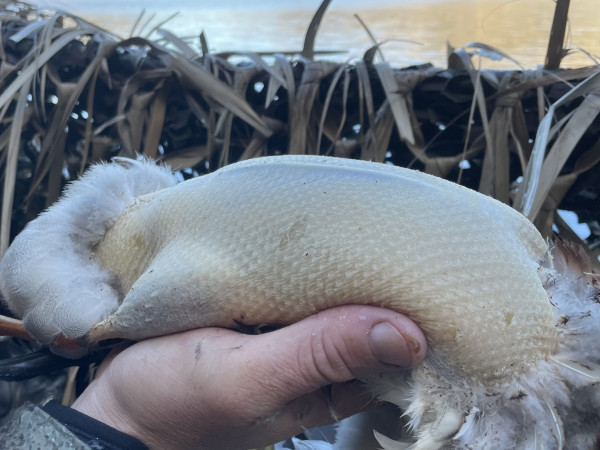Both Barrels June 2024 - Otago
- Otago
- 20/06/2024
Late-season hunting for mallards
Picture Above: This laydown blind worked best for mallards in a paddock in the first hours of morning light but needed more greenery for cover. While the mallards eventually got shy, the parries kept on coming. Photo: Bruce Quirey
Hunting late-season mallards in Otago presents different challenges and opportunities. Here are five tips to help improve your success:
- Scout Regularly: Late in the season, mallards become more wary and change their habits. Scouting is the key to knowing where the birds are feeding, loafing and traveling. Focus on finding these hotspots and hunt accordingly. Avoid ponds and backwaters that freeze.
- Use Smaller Decoy Spreads: By this time, many drakes are without mates and looking for opportunities to pair up. Use smaller decoy spreads with well-separated pairs to mimic the appearance of naturally paired ducks. This set-up can attract lone drakes looking to steal a mate.
- Improve Your Camouflage: Use natural vegetation from the area to cover your blind and yourself. Ensure there are no shiny or unnatural surfaces visible.
- Adjust Your Calling: Late-season ducks have heard a lot of calling and can be more call-shy. Use subtle and realistic calls, and avoid overcalling. Pay attention to the ducks' reactions and adjust your calling strategy as needed to avoid spooking them.
- Venture Further: Ducks may shift to less pressured areas later in the season. Explore new locations such as smaller ponds, backwaters, and secluded creeks that may not have been heavily hunted earlier. These areas can provide opportunities to find less wary birds.
Laydown blind hunting
Using a laydown blind is an effective way to hunt ducks, allowing you to blend into almost any environment. Here are five tips to maximise your success:
- Choose the Right Location: Position your laydown blind in an area where ducks frequent. Look for spots with natural cover, such as tall grass or shrubs, and ensure you have a clear view to spot incoming ducks.
- Camouflage Effectively: Make sure your laydown blind is well-camouflaged. Use natural vegetation from the area to blend the blind into the surroundings.
- Stay Still and Quiet: Ducks have keen eyesight and are easily spooked by movement and noise. Once you're in position, remain as still as possible.
- Use Decoys Strategically: Place decoys around your blind to create a natural and inviting setup. Spread them out in a realistic pattern, with some grouped together and others spaced apart.
- Practise Your Shot: Shooting from a laydown blind can be different from other positions. Practise mounting your gun and taking shots while lying down to become comfortable and proficient.

Picture Above: A fat southern lake mallard plucked and singed shortly after it was shot. Photo: Mason Court
Pluck your duck
Plucking a duck right after you have shot it can be easier and helps preserve the quality of the meat.
- Start while the duck is still warm, because the feathers and skin are more pliable, reducing the risk of tearing the skin.
- Hold the duck by its feet and start plucking feathers from the breast area, working your way toward the wings and back.
- Pluck small sections at a time, pulling feathers in the direction they grow to minimise skin tears.
- Use a propane torch or gas stove to singe any remaining small feathers, to provide a cleaner finish for cooking.
Dispose of carcases responsibly and remove all rubbish from the hunting area.

Picture Above: Aya watches and waits after two early-morning retrieves. Photo: Mason Court
Rug up Rover
As the cold extremes bite in winter, keeping your dog warm during duck hunting is important for their comfort and safety.
- Use a Dog Vest: Fit your dog with an insulated neoprene vest.
- Provide a Warm Resting Spot: When your dog is not actively retrieving, provide a warm, dry place for them to rest.
- Keep Your Dog Dry: Dry your dog off with a towel after each retrieve, especially if they've been in cold water.
- Monitor Your Dog: Regularly check your dog's condition during the hunt. Look for signs of hypothermia, such as shivering, lethargy, or a drop in body temperature.
- Energy Food: Give your dog high-energy snacks during the hunt to help maintain their body temperature.
Picture Above: A splasher spinner decoy can create subtle movement but don’t over-do it. Photo: Bruce Quirey
Motion decoys
Late in the season, ducks are more cautious.
By now, many hunters have put away their spinning wing decoys. If you do want to use motion decoys, choose subtle, realistic movements rather than exaggerated actions. Decoys that create slight ripples or gentle wing flaps can be more convincing to wary ducks.
Jerk rigs are a simple, cost-effective way to create movement on the water without breaking the bank. To make a jerk rig, you’ll need:
- Cord or fishing line
- Fishing clips
- 2-3 metres of elastic cord
- Heavy sinker or stake for an anchor
Method: Tie the elastic to the anchor and then attach the cord to the other end. Tie a small loop on the cord at arm-length intervals. Attach the decoys to the loops using fishing clips. Set the anchor in the water. Once set, pull the cord to move the decoys. The elastic will snap back, causing the decoys to move.
Otago Key Dates for 2024
Otago is fortunate to have sufficient wildlife resources to sustain a 12-week game bird season for mallards.
- Closing Weekend: Mallard and shoveler season closes on Sunday, July 28.
- Paradise Shelduck: Season closes on Sunday, August 25.
- Black Swan: Area B closes on Sunday, August 25. Note that Area A, the Clutha River catchment above Clyde Dam, is closed.
- Upland Game Birds: Season closes on Sunday, August 25.